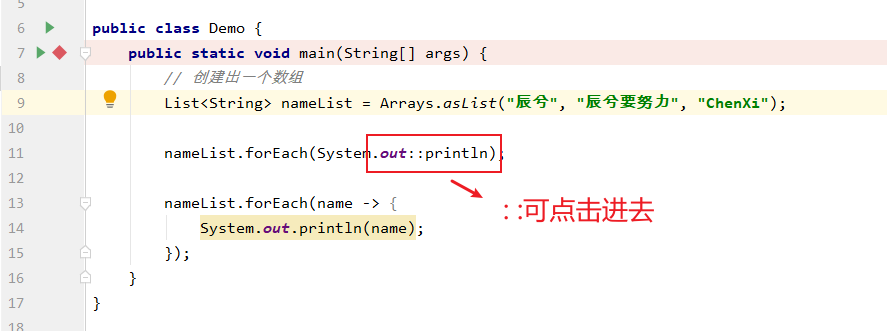【Java8新特性】揭开System.out::println的神秘面纱
【辰兮要努力】:hello你好我是辰兮,很高兴你能来阅读,昵称是希望自己能不断精进,向着优秀程序员前行!
博客来源于项目以及编程中遇到的问题总结,偶尔会有读书分享,我会陆续更新Java前端、后台、数据库、项目案例等相关知识点总结,感谢你的阅读和关注,希望我的博客能帮助到更多的人,分享获取新知,大家一起进步!
吾等采石之人,应怀大教堂之心,愿大家奔赴在各自的热爱里…
一、文章序言
第一次看到这个输出语句还是觉得挺有趣的,本篇文章带你揭开System.out::println的神秘面纱
List<String> nameList = Arrays.asList("辰兮", "辰兮要努力", "ChenXi");
nameList.forEach(System.out::println);
- 1
- 2
思考一下这个会输出什么?

对就是正常的遍历输出了集合中每一个具体的对象
辰兮
辰兮要努力
ChenXi
- 1
- 2
- 3
二、案例学习
如下的两种方式其实输出是相同的
nameList.forEach(System.out::println);
- 1
即调用了某一个对象的某一个方法
nameList.forEach(name -> {
System.out.println(name);
});
- 1
- 2
- 3
输出结果
辰兮
辰兮要努力
ChenXi
- 1
- 2
- 3
就是把你遍历出来的每一个对象都用来去调用System.out的println方法。
System.out::println这段代码其实就是Consumer接口的一个实现方式

点进去
@FunctionalInterface
public interface Consumer<T> {
/**
* Performs this operation on the given argument.
*
* @param t the input argument
*/
void accept(T t);
/**
* Returns a composed {@code Consumer} that performs, in sequence, this
* operation followed by the {@code after} operation. If performing either
* operation throws an exception, it is relayed to the caller of the
* composed operation. If performing this operation throws an exception,
* the {@code after} operation will not be performed.
*
* @param after the operation to perform after this operation
* @return a composed {@code Consumer} that performs in sequence this
* operation followed by the {@code after} operation
* @throws NullPointerException if {@code after} is null
*/
default Consumer<T> andThen(Consumer<? super T> after) {
Objects.requireNonNull(after);
return (T t) -> { accept(t); after.accept(t); };
}
}
- 1
- 2
- 3
- 4
- 5
- 6
- 7
- 8
- 9
- 10
- 11
- 12
- 13
- 14
- 15
- 16
- 17
- 18
- 19
- 20
- 21
- 22
- 23
- 24
- 25
- 26
- 27
- 28
我们可以自己创建一个类来模仿System.out::println这样的输出方式
/**
* 2021-7-25 12:01:54
* 辰兮要努力
*/
public class PrintlnDemo {
/**
* 创建一个打印的输出方法
*/
public void printDemo(String a) {
System.out.println(a);
}
}
- 1
- 2
- 3
- 4
- 5
- 6
- 7
- 8
- 9
- 10
- 11
- 12
- 13
- 14
案例实践
/**
* 2021-7-25 12:02:50
* 辰兮要努力
*/
public class Demo {
public static void main(String[] args) {
// 创建出一个数组
List<String> nameList = Arrays.asList("辰兮", "辰兮要努力", "ChenXi");
//输出案例
nameList.forEach(System.out::println);
//创建一个demo模仿如上的打印输出功能
nameList.forEach(new PrintlnDemo()::printDemo);
}
}
- 1
- 2
- 3
- 4
- 5
- 6
- 7
- 8
- 9
- 10
- 11
- 12
- 13
- 14
- 15
输出结果

三、项目实践
创建一个学生类
@Data
public class Student {
private int age;
private String name;
}
- 1
- 2
- 3
- 4
- 5
获取list集合里面的某两个属性转换为map集合存储
/**
* 2021-7-25 12:13:35
* 辰兮要努力
*/
public class Demo {
public static void main(String[] args) {
Student student = new Student(20,"辰兮");
Student student1 = new Student(22,"辰兮要努力");
Student student2 = new Student(21,"ChenXi");
ArrayList<Student> list = new ArrayList<>();
list.add(student);
list.add(student1);
list.add(student2);
//实现List转换为Map
Map<String,Integer > map = list.stream().collect(Collectors.toMap( Student::getName,Student::getAge));
System.out.println(map); //{ChenXi=21, 辰兮要努力=22, 辰兮=20}
}
}
- 1
- 2
- 3
- 4
- 5
- 6
- 7
- 8
- 9
- 10
- 11
- 12
- 13
- 14
- 15
- 16
- 17
- 18
- 19
- 20
- 21
- 22
- 23
输出结果
{ChenXi=21, 辰兮要努力=22, 辰兮=20}
- 1
本方法的业务场景还有很多,我们根据实际的业务进行实践应用即可
分享一下相关文章:秋招Java-面试官就System.out.println()考了我半个小时?

相信你一定有所收获我们下期再见!
非常感谢你阅读到这里,如果这篇文章对你有帮助,希望能留下你的点赞👍 关注❤️ 分享👥 留言💬thanks!!!
2021年7月25日12:25:25 愿你们奔赴在自己的热爱里!
文章来源: blessing.blog.csdn.net,作者:辰兮要努力,版权归原作者所有,如需转载,请联系作者。
原文链接:blessing.blog.csdn.net/article/details/119080121
- 点赞
- 收藏
- 关注作者



评论(0)